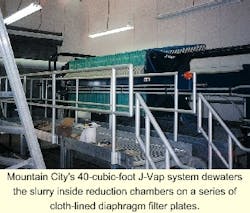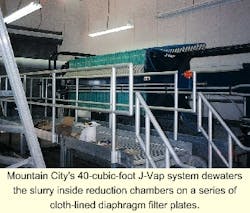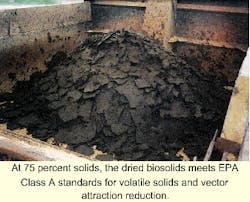Plant Gains Flexibility with One-Step Dewatering/Drying Process
Before completing an expansion and upgrade last year, the Mountain City wastewater treatment facility faced severe constraints. A shortfall in treatment capacity left the northeast Tennessee community under a state-imposed sewer-connection moratorium that hindered efforts to attract new housing, tourism and industry. Class B biosolids produced on drying beds restricted options for beneficial use. Limited drying capacity on the beds also influenced activated sludge waste rates, making process control a challenge.
Today, after a capacity upgrade from 0.9 mgd to 1.2 mgd and the addition of a one-step biosolids dewatering and drying process, Mountain City has gained more control of its destiny. The biosolids process in particular promises flexibility, with ability to yield Class A material, suitable not just for land application but for community distribution. Furthermore, the process has substantially reduced labor costs, according Danny Sims, chief operator.
The J-Vap dewatering and drying system, supplied by USFilter's Dewatering Systems Group based in Holland, Mich., yields dried cake at greater than 75 percent solids in a single, fully automated process. The system is capable of delivering cake at greater than 95 percent solids.
Need for Change
Before undertaking the treatment plant upgrade, Mountain City dried biosolids on five 1,600-square-foot drying beds. Waste activated sludge was delivered to the plant's aerobic digesters, then piped to the beds, where it typically dried to 50 to 70 percent solids in four to six weeks.
Bed cleaning was a full day's work for a two-person crew. Even loading the drying beds was labor intensive, requiring essentially full-time operator attention. As plant flows increased, drying bed capacity became constrained.
"Our solids drying was driven solely by the capacity of the digesters," Sims said. When digester space ran out, beds sometimes had to be cleaned as low as 20 to 30 percent solids to make room for new material.
"The shortage of drying capacity affected our process," Sims said. "At times, we didn't have enough room to waste sludge from the system. That made it difficult to optimize the mixed liquor."
Mountain City staff hauled the dried material to a 300-acre dairy farm and applied it to the soil surface; the farmer then incorporated it using a disc.
"With Class B material, we face a shortage of available land within cost-effective hauling distance," Sims said. "This is hilly country, and runoff is a concern. On many farms in this area, slopes exceed the limits set in federal and state regulations.
"Class A material can make more land available and give us other options as well," he said.
Class A System
The Mountain City plant upgrade included installation of a new 50,000-gallon aerobic digester in late 1999, adding to 125,000 gallons of existing digester capacity. The plant now processes average flows of 800,000 gpd. The J-Vap system began operation in May 2000.
The plant wastes sludge to the digesters at 7,000 gpd of slurry at one percent solids. Secondary sludge in the digesters is typically at 1.5 to 2.5 percent solids. Centrifugal pumps transfer material from the digesters to a mixing tank for chemical treatment with a ferric chloride polymer blend. The blended slurry then enters the J-Vap unit via diaphragm pumps.
Mountain City's 40-cubic-foot J-Vap system (ultimately to be expanded to 50 cubic feet) dewaters the slurry inside reduction chambers on a series of cloth-lined diaphragm filter plates incorporating a drainage surface for filtrate removal. An LP-gas-fueled energy conversion module supplies heated water for pressurization and drying and includes a vacuum system used during the drying stage.
During the batch process, the filter plates are clamped tightly together in a specially designed filter press. Slurry enters the filter chambers, where initial filtration takes place and free liquid is removed. Filtrate flows through the filter cloths, leaving a filter cake.
After filtration, the vacuum/drying cycle begins. The feed pumps stop, the feed and filtrate valves close, and the reduction chamber diaphragms are pressurized to 100 psi to squeeze the filter cake and remove as much water as possible.
Hot water at 180F is circulated in a closed loop behind the diaphragms to heat the filter cake. At the same time, a vacuum is introduced to the filter chambers, causing water remaining in the filter cake to boil off at a low temperature. Cycle time can be adjusted to reach the desired moisture content.
At the end of the drying cycle, a pathogen kill cycle begins. The vacuum is turned off, raising the boiling point within the unit, thus raising the material temperature to meet U.S. Environmental Protection Agency time and temperature requirements.
By drying the material at low temperature, the J-Vap unit conserves energy. Air exhaust from the unit is minimal, requiring no air-quality permits. Mountain City cools the vapor from the unit using plant effluent passed through a heat exchanger. Condensate returns to the head of the treatment plant.
In the early stages of J-Vap operation, when the facility faced a sludge overload, Mountain City processed eight batches per day with a two-hour slurry feed cycle and one-hour drying time. The drying time has since been extended, and the unit now processes one or two batches per day.
Sims and operator Randy Forrester appreciate the system's automatic operation.
"We just push a couple of buttons and go back to work," Sims said. After a drying cycle, the material falls off the filter cloth onto a conveyor that empties it into a truck for delivery to the land application site.
More flexibility
At 75 percent solids, the material meets EPA standards for volatile solids and vector attraction reduction. Mountain City is in the process of laboratory testing to verify sufficient pathogen kill and receive Class A certification from the Tennessee Environmental Protection Agency.
As the city looks to producing certified Class A biosolids, more beneficial use options present themselves, Sims said. One possibility being discussed is to make the material available to the community as a fertilizer, either picked up at the plant or delivered to homeowners. Because Mountain City's flow is primarily domestic wastewater, the biosolids product is low in metals, thus fully suitable for flower and vegetable gardens.
More efficient solids handling is also leading to process improvements, Sims said. Before the facility upgrade, solids residence times in the plant's aerobic digester were brief, and the digester essentially served as a storage tank. Since the upgrade, digester residence times have increased to 15 days, and in the future Sims hopes to achieve the 30-day residence time required for complete digestion.
In the end, more efficient solids processing with the system has helped Mountain City improve its treatment plant operations and facilitate the community's growth and prosperity.


